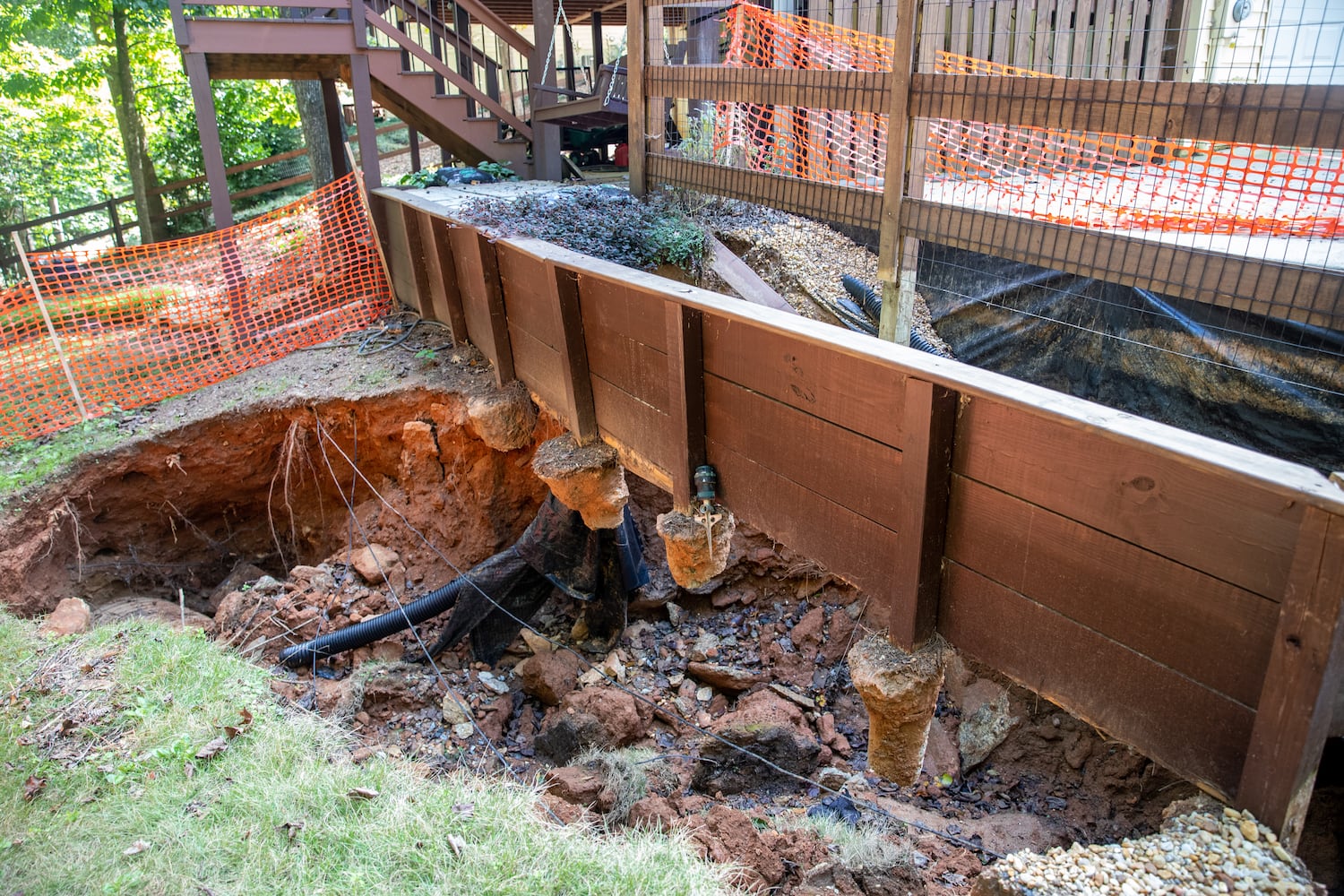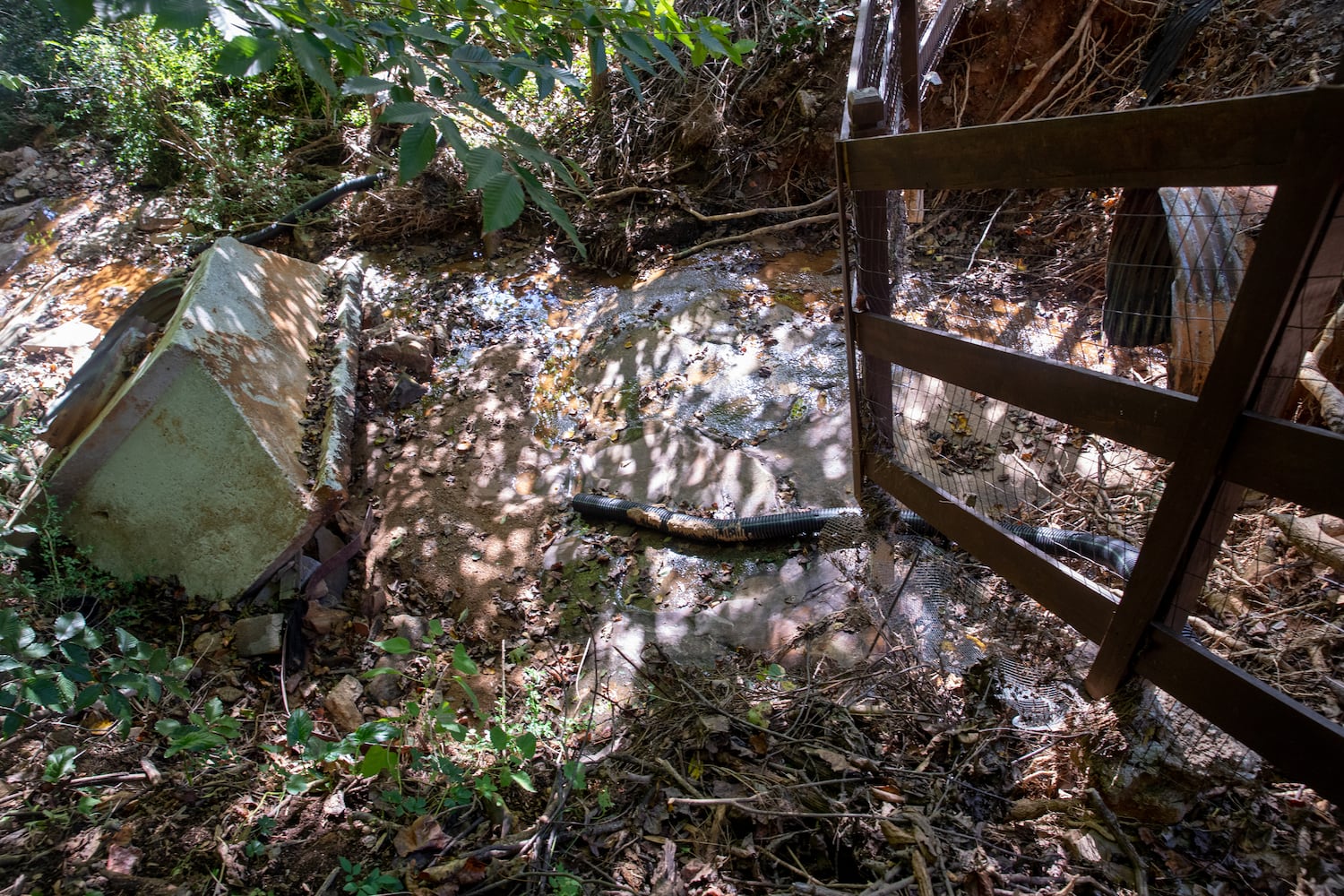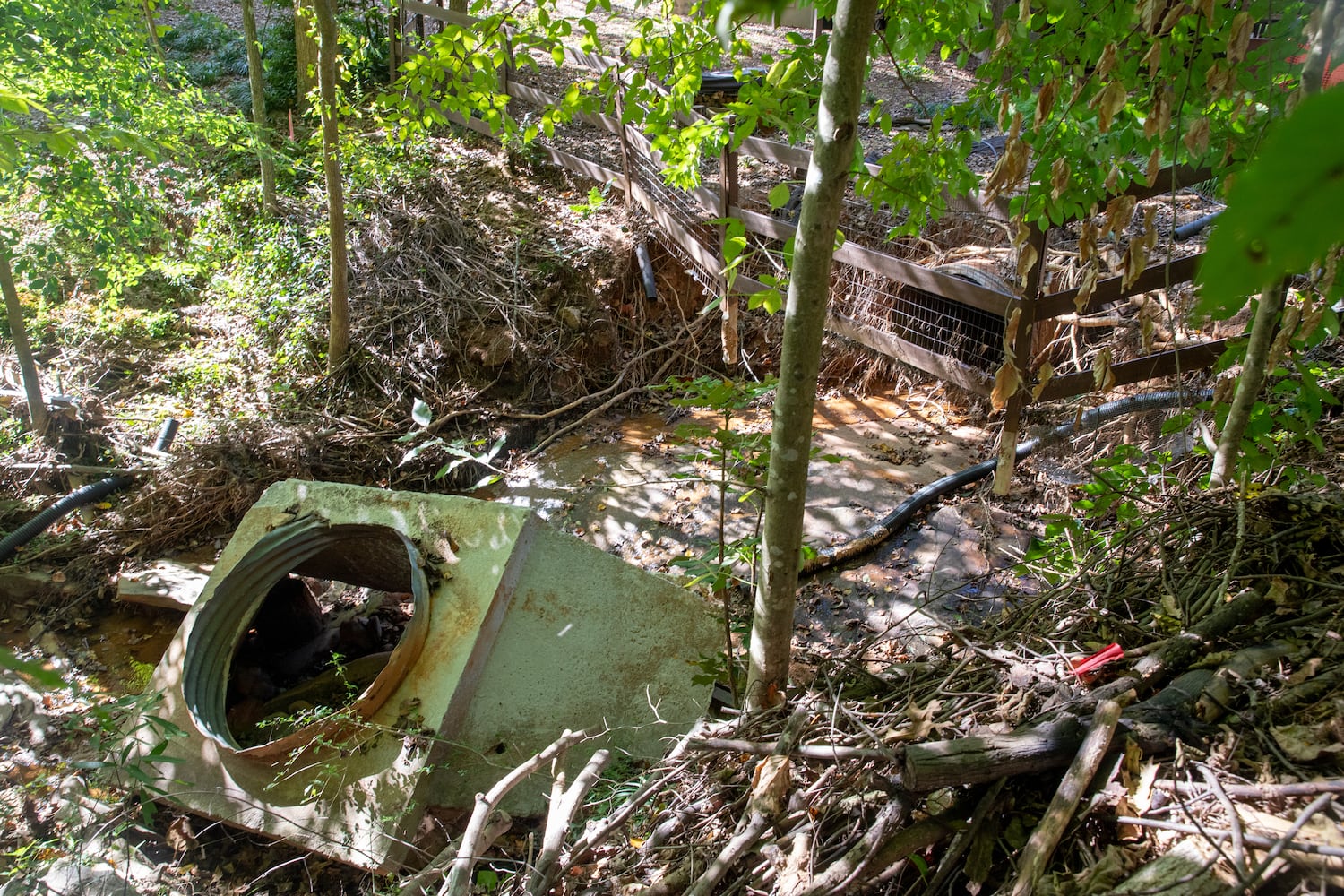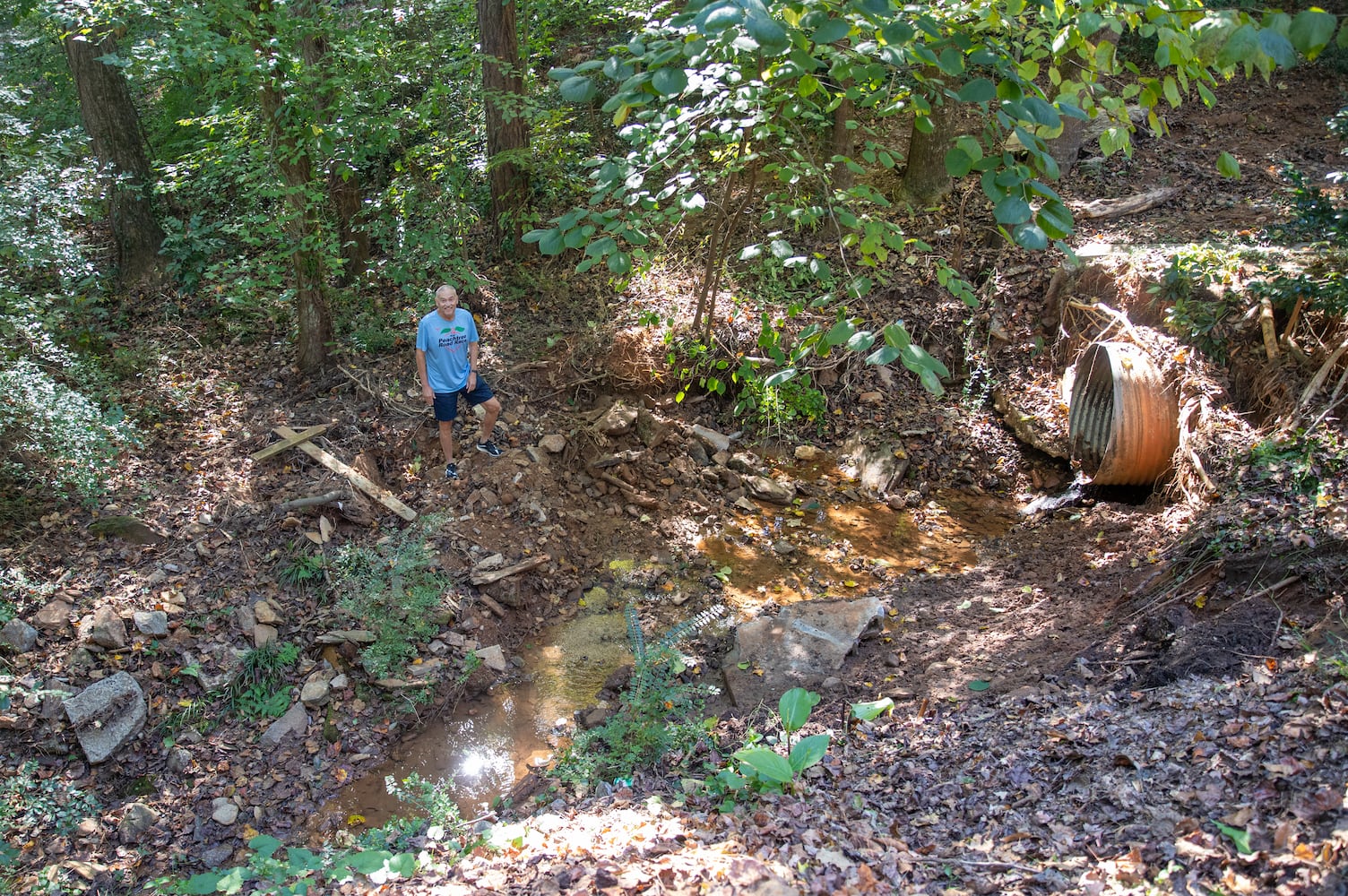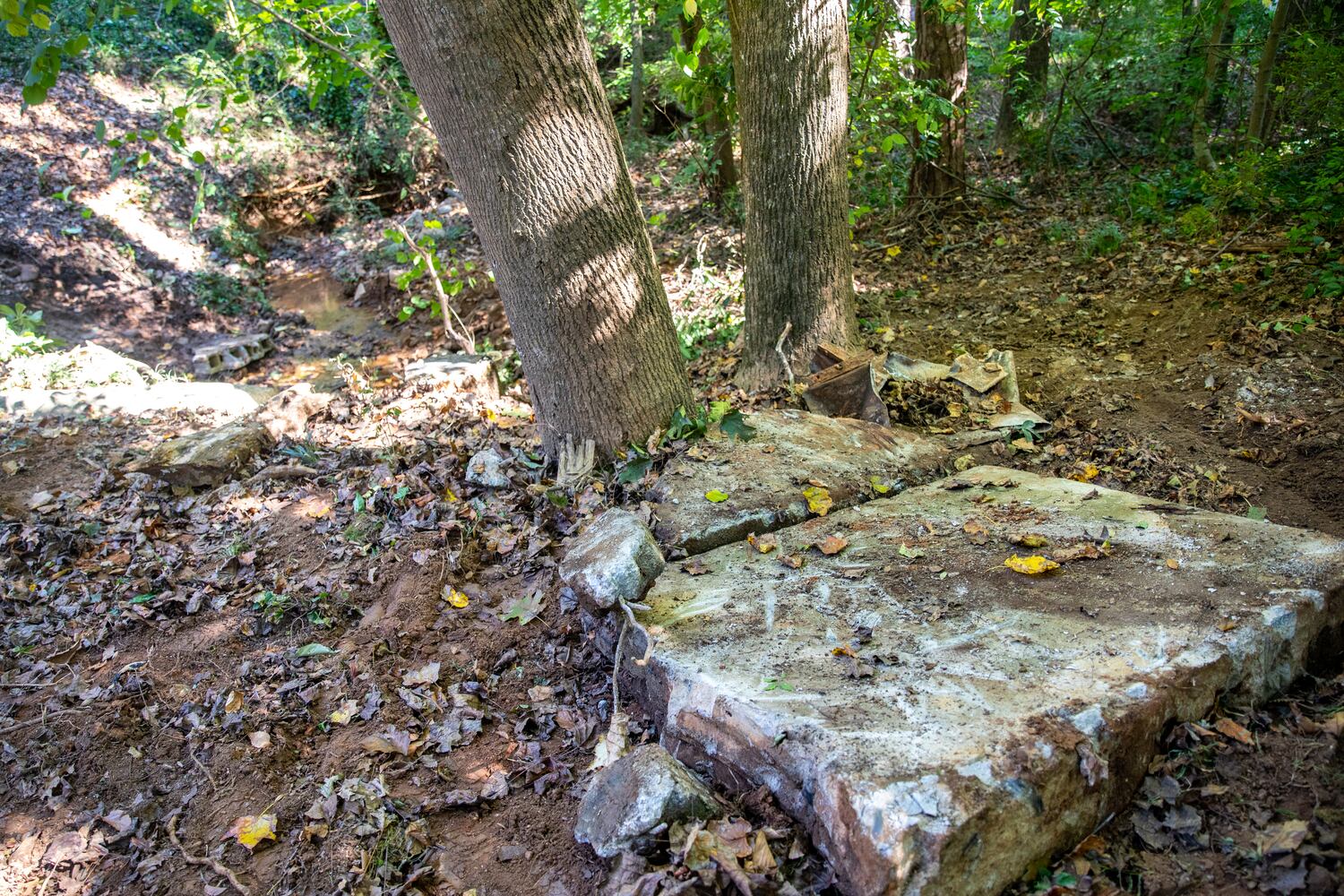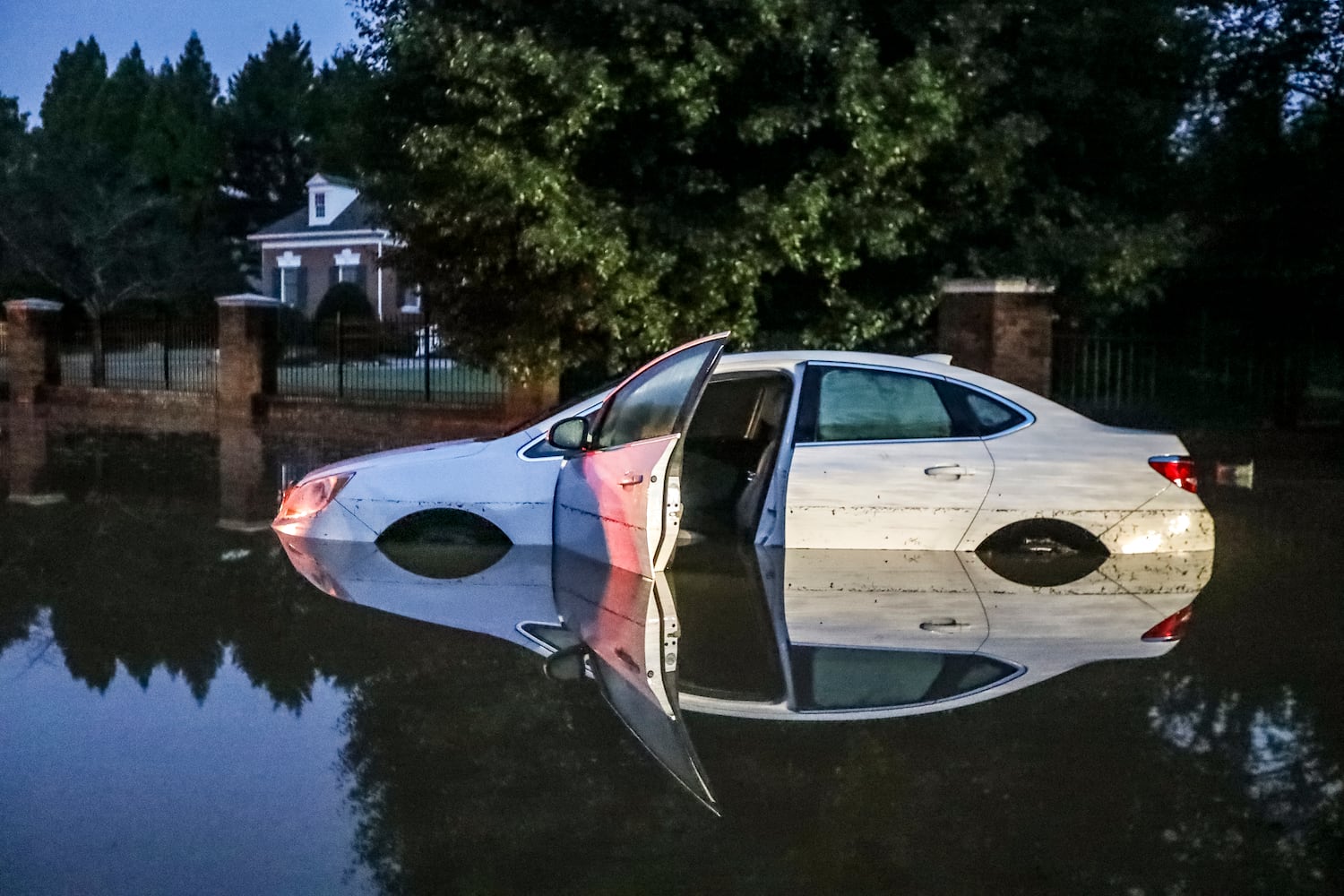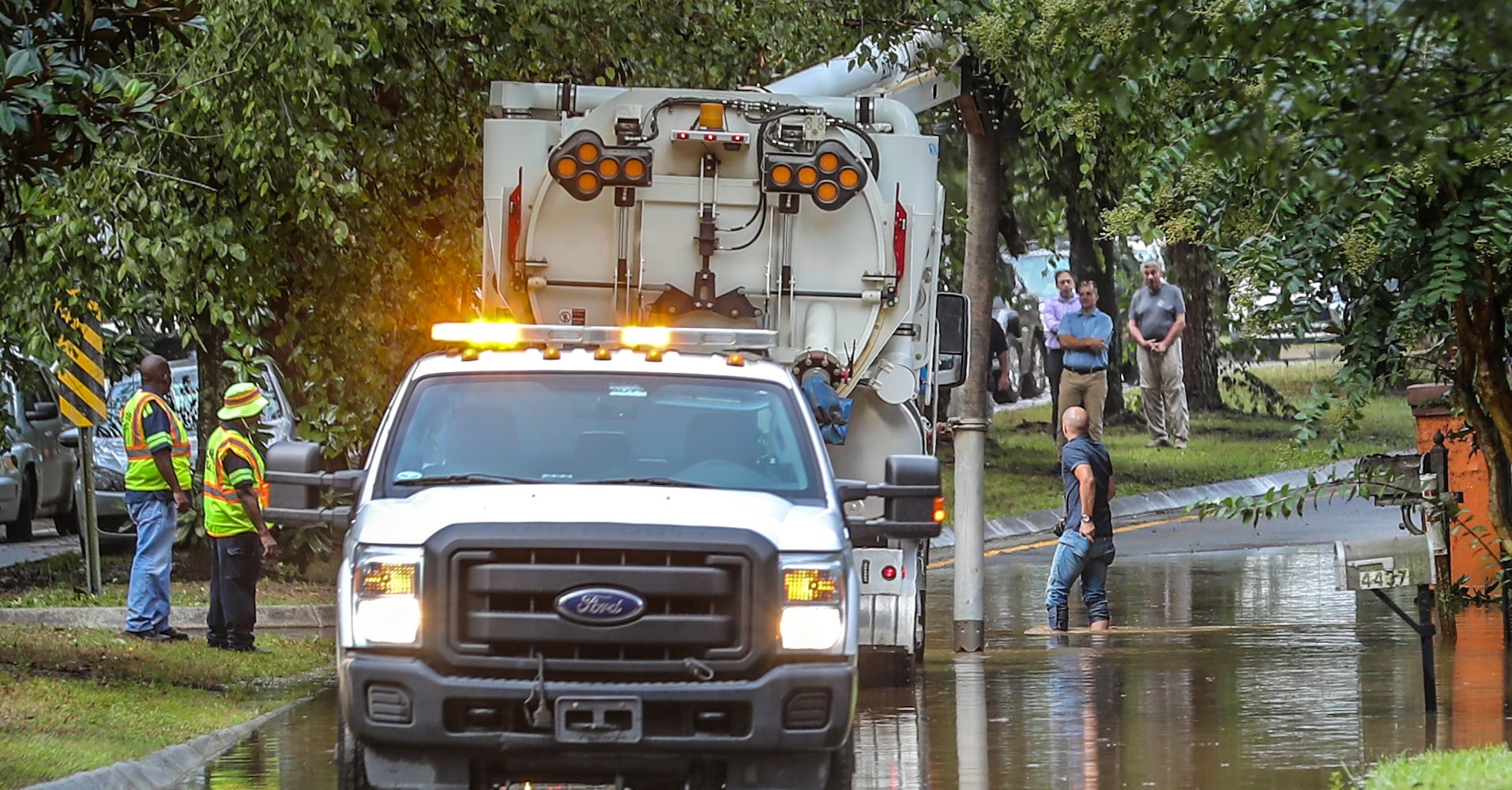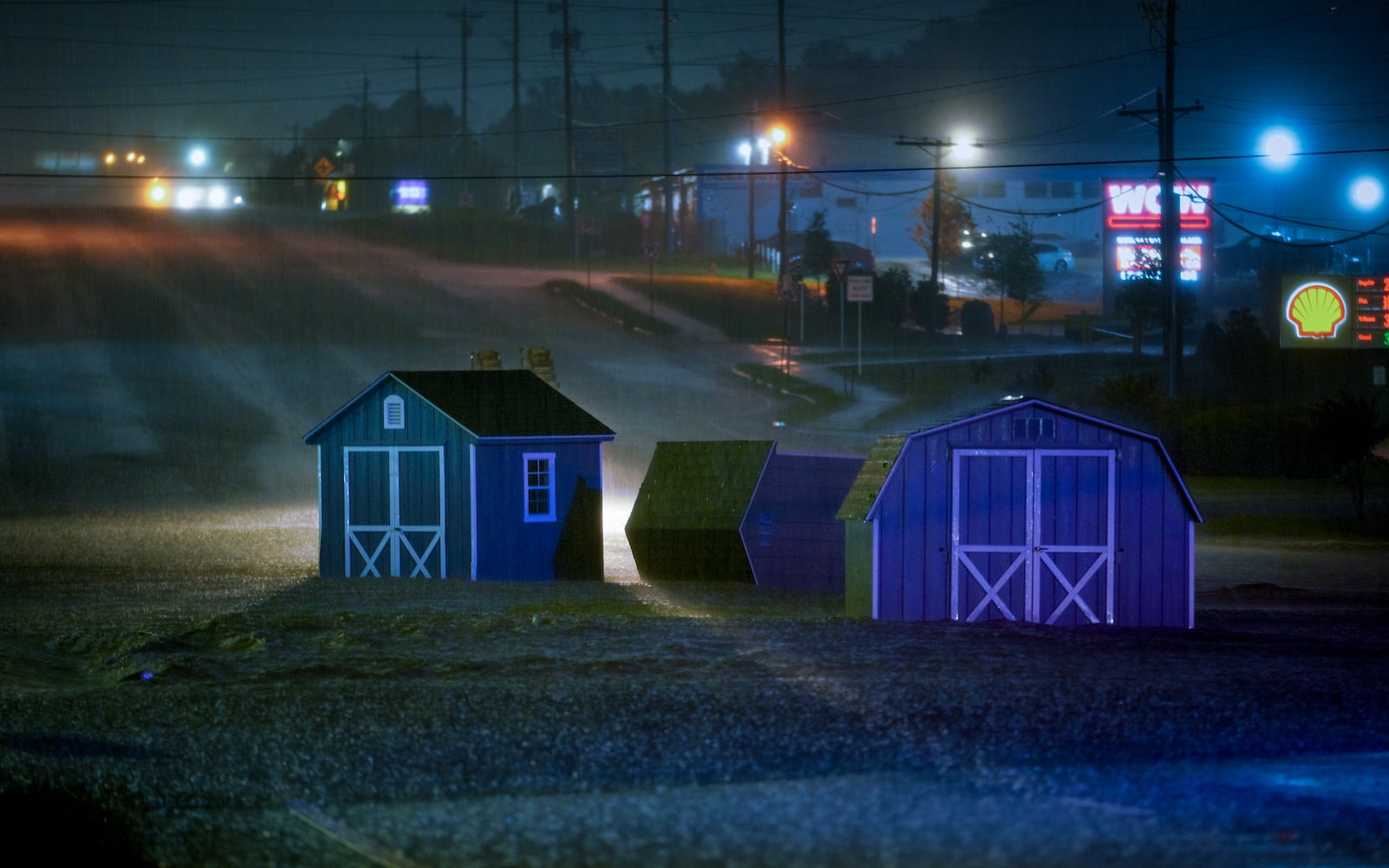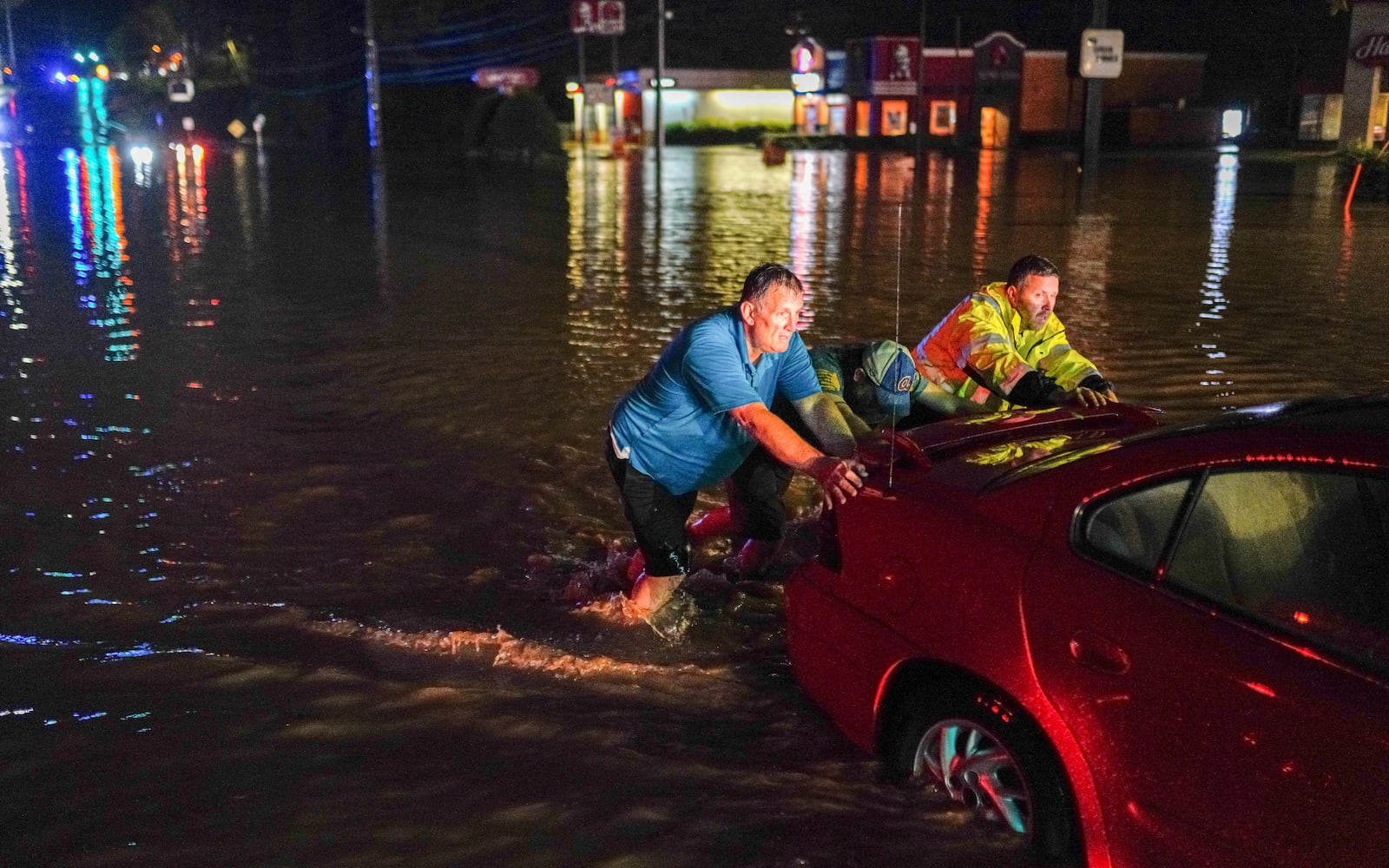When Rebecca Klein and Orion Smith moved into their east Cobb County home last year, they planned to live there a long time. Their hopes may have been washed away by an intense flash flood that ravaged the north Atlanta suburbs in September.
Klein and Smith are among the hundreds whose homes were damaged by a Sept. 7 storm that deluged parts of Cobb, Fulton, Gwinnett and Forsyth counties with several inches of rainfall over 24 hours.
The torrential downpour turned streets, yards and basements into shallow rivers, leveled trees, caused erosion and sinkholes, and damaged businesses as well as several government buildings in Cobb County.
Homeowners in east Cobb who spoke to The Atlanta Journal-Constitution say local and state government has turned its back on them in the eight weeks since. Smith described Cobb County’s flood mitigation system as “woefully inadequate” and said the county is shirking responsibility for damages its pipes failed to prevent. Cobb County leaders say their system wasn’t designed to handle a storm of such magnitude and their hands are now tied because the Federal Emergency Management Agency (FEMA) did not declare Cobb a disaster zone.
The September storm overflowed a creek in Klein and Smith’s neighborhood, causing floods that opened a massive sinkhole in their yard, exposing and destroying the underground culvert on their property. Now Smith and Klein may have to pay upward of $200,000 to repair the storm pipe and the expanding sinkhole, which threatens the foundation of their home.
Cobb County officials determined that since the pipe was on private property, it’s not their responsibility to pay for the damages.
“We can’t afford that,” Klein said of the repairs. “And that’s insane for the county to expect a homeowner to take that over, especially when there’s no assurance that they’re going to make any corrections (to prevent future damage from stormwater).”
Klein and Smith believe the drainage pipe is public. They say a 1977 plat shows county officials signed off on drainage easements on their property before a developer built their house. Nonetheless, the couple may have to let the home go into foreclosure or file for bankruptcy.
The family has started a GoFundMe campaign to crowdfund for emergency repairs. Smith worries that even if he and Klein abandon ship, the county may take legal action against them if they don’t fix the damage.
“This is completely untenable for us. We have no way out,” he said. “It feels hopeless. We can’t stay in the house and we can’t leave the house.”
Credit: Matt Bruce
Credit: Matt Bruce
The couple is not alone. The storm caused structural damages and sent water flooding into hundreds of homes across Cobb. Many say they’ve been denied county assistance and are now drowning in repair bills that range between $25,000 and $200,000.
The U.S. Small Business Administration has declared Cobb County a disaster area and began offering flash flood victims low-interest loans up to $200,000.
That’s not enough, say frustrated homeowners who want Cobb to provide more aid and upgrade the drainage system countywide.
Cobb County water, transportation and emergency management officials who spoke to the AJC say there’s little more financial relief they can offer because the county’s damage assessments fell short of the threshold for FEMA assistance.
“What we’re doing is not unique; we’re just not responsible for these damages,” said Ordale Randall, the county’s Risk and Safety manager. “And I do understand where homeowners are coming from, but because it’s a natural occurrence, there isn’t much of anything that we can do as far as relief is concerned.”
Commissioner Jerica Richardson, who covers the east Cobb district that was one of the hardest hit areas in metro Atlanta, said she is working with state and federal partners to advocate for policy changes and address what she describes as “gaps in the system” when it comes to helping residents.
“It’s a gap and homeowners are left holding the bag here because there’s kind of this older philosophy of stormwater being a private management kind of thing,” Richardson said.“That you’re responsible for your property, even though we know there are shared flows and shared benefits.”
A 200-year storm
The devastation in Cobb is centered primarily around Sope Creek, an 11-mile stream that courses through the county and has a network of feeder canals and basins. Drainage pipes running through homeowners’ yards eventually flush into Sope Creek, which funnels stormwater to the Fulton County line and the Chattahoochee River.
Credit: Matt Bruce
Credit: Matt Bruce
Cobb is currently completing a rainfall analysis of what appears to be a 200-year event, meaning there’s a 0.5 percent chance of such a storm happening in any one year.There were reports of four inches of rainfall in less than three hours in some spots.
The county’s stormwater drainage is designed to withstand 100-year storms, which officials say is the standard for municipal systems nationwide.
FEMA and GEMA disaster teams visited about 200 homes in the county’s worst hit parts to assess damages Sept. 24. They visited an additional 100 homes during tours Oct. 21 and 22, according to Cobb County Emergency Management Director Cassie Mazloom.
So far, FEMA has categorized 101 homes as having major damage. Officials have not yet put a dollar amount on the storm’s devastation.
Richardson sponsored an Oct. 14 virtual town hall to answer residents’ questions. State Sen. Kay Kilpatrick (R-Marietta) spoke briefly during the forum and noted that Newnan was denied FEMA dollars even after an EF4 tornado tore through that city March 25 and damaged more than 1,700 homes.
“Since our (storm) was a localized area, I suspect that’s why the county did not meet the threshold,” Kirkpatrick told Cobb residents.
Some residents are advocating for the county to make stormwater management a stand-alone utility. The revenue from charging homeowners and developers an impact fee, they say, could be used to bolster the county’s drainage system and add staffing for more upkeep.
Richardson moved to metro Atlanta after her family evacuated New Orleans for Hurricane Katrina. She said homeowners’ pockets too often get hit when severe storms occur.
She’s taken a “multidimensional” approach that could include changes at the county level and working with state and federal programs and policy makers to find relief. She hopes to find ways to invest in a smart-tech infrastructure that would allow detention ponds to communicate with upstream and downstream ponds during a storm event to alert them if they’re overflowing.
“This is not just Cobb County, this is every county in America,” Richardson said. “It’s an entire culture change (needed) because no one in America has it where stormwater is maintained as a full network. It’s all the responsibility of that HOA or that property owner or what have you. And to me, it opens up a lot of issues, especially when you look at frequency by which floods, fires and tornadoes are occurring.”
Blind spots in the system?
After the storm, Hill Wright formed an advocacy group to help homeowners on the cusp of financial ruin.
The group provided residents a way to calculate their damages. Within three weeks, it had grown to over 100 members and about 30 homeowners had reported more than $1.2 million in worth of damages, Wright told the AJC.
The goal is to get the county to listen to residents and work with them to ensure this doesn’t become a common occurrence.
“This storm has really highlighted that hey, we’ve got a bigger problem. And we’re trying to get that in front of them,” Wright said.
Prior to 1974, builders were not required to record the location of pipes on county property maps called plats, said Cobb County Stormwater Management Division Manager David Breaden. Wright contends the county’s drainage maps are incomplete and officials are not sure what’s theirs to maintain, particularly on older properties.
Breaden said Cobb relies on its subdivision plat to determine which pipes have been conveyed to the county. For the drainage systems that predate the county’s archives, inspectors look for factors like whether the pipes are hooked into the roadway infrastructure, a good indication that they were installed with the original development and are the county’s responsibility.
“The question comes in on those older developments prior to ‘74,” Breaden said. “How do you determine what pipes were put in when there’s no real record of it? And that’s a judgment call.”
‘We are the victims’
The creek on Jeff Dawson’s property rose several feet and collapsed his driveway before spilling into Klein and Smith’s yard next door. With the concrete pavement broken into pieces, three vehicles parked on the top of his hillside driveway were trapped. They remained stuck there for more than a month. Vehicles parked at the bottom of the driveway were submerged during the storm and ruined.
Several of members of Dawson’s church helped build a wooden footbridge over the creek so his family can safely cross it. Now he’s got to fix the driveway and help replace the 48-inch corrugated pipe that was destroyed by the flood. He estimates that could cost more than $100,000.
“I would like to get assistance, but at this point I’m not really holding my breath,” Dawson said. “I’m just really disappointed that I’ve got to take out another mortgage on my house to pay for this.”
Developers built a dam across a natural stream in Jack Zhang and his wife Zhaojin Song’s yard before they moved into the four-bedroom ranch house along Jesters Court. The dam overflowed during the September storm and four feet of water poured in, essentially turning their backyard into a retention pond.
The flood waters leveled a backdoor and sent three feet of runoff crashing into the family’s finished basement, destroying $12,000 worth of appliances, drywall and furniture.
Emotion crept into Song’s voice as she as she stood in her basement last week and recalled the ordeal. She estimated it will cost nearly $100,000 to complete the renovations.
“Everything’s gone,” she said tearfully. “We are the victims. We did not do anything wrong. This mistake was not made by us. We’ve already lost so much.”
A few miles upstream, storm water destroyed an embankment on Ed Hullender’s Spring Creek Way property, and he may have to pay as much as $60,000 to replace the concrete barrier.
Adam Stewart had a sinkhole carved out beneath his backyard patio. County officials agreed to pay make some of the repairs on his property, but determined Stewart’s drainage pipe was extended at some point because only half the pipeline appears on county plats. That leaves him on the hook for about $25,000 to install the new infrastructure.
“It’s kind of analogous to forcing homeowners to be responsible for the power lines that go through their yard,” Stewart said.
Mallory Snipes gave birth 10 days before the flash flood. She retreated to the basement with her family during the storm to ride it out. Snipes and her husband woke up to flood water flowing into their Indian Hills home as their newborn son slept in his bassinet on the basement floor.
“I put my feet down and it was like ankle deep water. It was just a nightmare,” she recalled.
A failed pipe on their neighbors’ shared property was to blame. That pipe wasn’t on the county’s plats either. Now the young couple must cough up $37,000 to protect their home.
“We don’t have $37,000 lying around. I’m going to go back to work in December and childcare is so expensive,” Snipes said. “I feel like my maternity leave got hijacked because I haven’t been able to just take it in and enjoy it because I’m stressed out about this.”
Credit: Matt Bruce
Credit: Matt Bruce
About the Author
Keep Reading
The Latest
Featured

